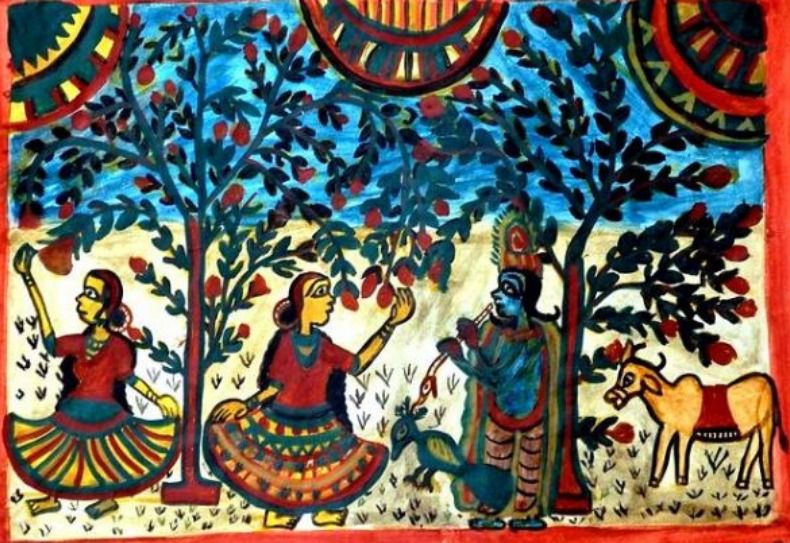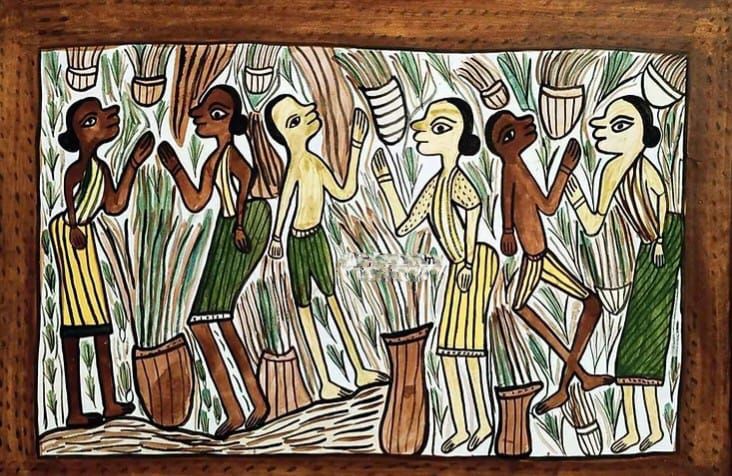Jadopatua Paintings: Stories on Scrolls
These paintings were popular in Jharkhand's Dumka district, the sacred home of Jadopatua. The word 'Jadopatua' means 'magic painters.' This art form is generally practiced by the Santhals, the third-largest tribe in India. Some sources believe that the word 'Jado' in Santhali, meaning artist, gives rise to the name. Jadopatua paintings are vertical scrolls originally created on cloth, but they are now also made on paper. These paintings often depict stories about the origins of life, life after death, Hindu mythology, history, and tribal life, including rituals and festivals. This unique art form uses natural pigments derived from stones, leaves, flowers, and tree bark, all intricately applied to scrolls of varying lengths.
History of Jadopatua Paintings

Jadopatua Scroll, (image source: Pinterest)
The artists behind Jadopatua painting are of Bengali descent, primarily from the Santhal tribe, who migrated to Jharkhand centuries ago. This community of painters, known as Jadopatua, includes individual artists referred to as 'chitrakars'. The traditional artworks of this region are known as 'Paitkar', a form of art that has been practiced in the village since ancient times. The hamlet of Paitkar, located in the eastern part of Jharkhand, is called Amadubi. Jharkhand tribal artisans have cultivated the art of scroll painting, which has long been employed in storytelling and socio-religious rituals. Paitkar painting is derived from Pandulipi (ancient scrolls), which were once used by kings to send messages to one another. This painting in santhal tribe was created by a group of people known as Jadu patuas who live in santhal prangan. It is said that the name "Jadopatua" was first coined by Nitai Chitrakar, a painter from West Bengal.
Pata Paintings

Pattachitra scroll art: (image source: Direct Create)
Pata painting or Pattachitra is one of the earliest forms of folk art. Known for its vertical scroll format, Pattachitra painting is popular in regions such as West Bengal, Bihar, Odisha, and other parts of India. These paintings often depict the daily lives of people in Bengal and Jharkhand. In West Bengal, the Pattachitra painting community is referred to as "Patua." The name "Pattachitra" is derived from "Padya," with its origins traced through the words Pata (scroll) and Chitra (painting). In Jharkhand, these artists are known as Patidar, Patekar, and Paitkar as mentioned before.
Materials and Techniques

Traditional colour used Jadpatuas Paintings, (image source: popbaani)
The scrolls were crafted from sheets of paper, glued or sewn together, and often wrapped in fabric to protect the artwork. In ancient times, these scrolls were even made from waste paper. A unique element of Jadopatua is the backing, which frequently uses recycled sari fabrics, adding aesthetic complexity to the presentation. The brushes used by ancient Jadupatuas were made from goat hair, tied to small sticks. To create vibrant colors, natural ingredients were used. Leaves and flowers were mixed with natural gums from the babool tree, which made the paint durable and added a glossy finish.
Some commonly used colors in Jadopatua art include:
Red: Hematite (Gerua Patthar)
Yellow: Yellow Ochre (Haldi Patthar) and Turmeric (Haldi)
Black: Lamp soot (Carbon Black)
Orange: Palash flowers
Brown: Brownstone
Green: Bean leaves (Seem Patta)
Blue: Indigo
Artistic Style

Jadopatua scroll, (image source: SVASA LIFE)
The majority of the painting features human figures, portrayed in both profile and semi-profile views. Santhal women are depicted as tall, dignified figures that echo the graceful movements of traditional Santhal dance, sometimes interrupted by zigzag patterns. Men are shown with curly hair and dressed in traditional Bengali attire. Artists deliberately use distortion to enhance expression, using colors to symbolize various emotions such as happiness, romance, and drama. Animals like tigers are painted with large, intimidating heads, while blue elephants and red horses add a sense of wealth and grandeur. The artwork often reflects scenes from the Dumka and Jamtara societies.
Stories and Theme

Harvest Dance: (image option: Maati Ghar)
Jadopatua paintings beautifully capture the rich traditions and rituals of the Santhal community, particularly during the Sohrai celebration, which follows Diwali. In these paintings, villagers are shown taking animals to the forest in the morning and welcoming them back, a significant part of their harvest rituals. These paintings also depict themes of bonding, magic, and sorcery, often using symbolic imagery such as tortoises, which represent progress and survival. When a Jadopatua artist visits a home mourning the death of a loved one, they inquire about the deceased, assess the family’s resources, and then create a painting that reflects both the family’s story and broader themes of life, death, and continuity.
There are seven themes of Jadopatua painting:
1. Life in Death’s kingdom
2. The story of the creation of the santhals as preserved in santhal tradition
3. The santhal festival of Bahajatras
4. Mass meetings of the santhals for dancing
5. The personification of santhal clans
6. A tiger or leopard often with a human rider and
7. Finally, the adventures of Krishna with the milkmaid.
In conclusion,
Currently, Jadopatua artisans face challenges in sustaining their craft. Once known for their intricate, beautifully painted scrolls, they now primarily focus on painting scenes of daily life, hoping to sell their artwork to earn a living. Despite their efforts, they remain dissatisfied with their unstable income and lack of financial security. The demand for their paintings is low, making it difficult for them to thrive. In the Dumka region, only a few artists like Ganpati Chitrakar, Nitai Chitrakar, and Deodhan Chitrakar continue to practice this unique art form, striving to preserve their heritage.
To learn more about Indian art and artists, download the Rooftop app from the App Store or Google Play to stay updated on our upcoming art events and workshops. Stay tuned to rooftop blogs and follow us on @rooftop_app.
By Shrushti Patel